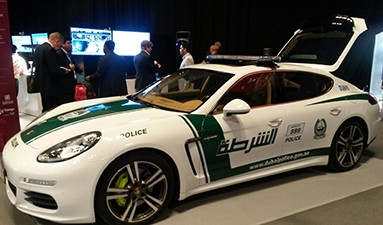
Connected police cars could help reduce crime and rake in cash for African cities if they choose to roll out the Internet of things (IOT) technology.
This is according to Lev Levin, director of Internet of everything (IOE) market development at Cisco, who was speaking to ITWeb on the side-lines of the Internet of Things World Forum (IoTWF) in Dubai this week.
Cisco has rolled out a connected law enforcement programme in Dubai in order to enhance safety, by using IP-enabled surveillance and sensors. This enhanced surveillance includes both officer body cameras and vehicle-mounted cameras that can relay live video tracking information on suspicious vehicles, while providing tactical information back to the command and control centre.
Cisco says the data can then help law enforcement to make decisions that "integrate and correlate live information on police cars, police personnel, their status and other sensor information".
"The solutions have been developed with the help of global engineers and we believe they have the potential to be rolled out anywhere in the world and would have huge positive impact for many African cities," according to Levin.
"The information is transmitted in real-time from situations in the field so law enforcement can respond immediately, track their personnel and increase accountability of police officers," says Levin.
Dubai pilot
As part of the pilot project, smart police cars are fitted with both rear and dashboard cameras. All data is transmitted to a GIS mapping system at the control centre, which can then map the movements of each officer and car in real-time for more effective policing. If something is out of the ordinary pattern, the system will trigger alerts at the control and command centre. There is also facial recognition software imbedded in the system, which can help with more serious crimes, to alert authorities of wanted suspects that show up on camera footage.
Police officers also wear body cameras and a 'hexoskin' shirt under their uniforms that have special biometrics sensors to monitor vital information and transmit that back to central control. The system monitors fatigue and stress levels of officers by using biometric data like heart rate, breathing and body positioning in conjunction with body cameras. The control centre can see if one of its officers has been incapacitated and is lying horizontally, or if they are having a medical emergency, or just reaching fatigue levels that would be dangerous to their operations.
Levin says this technology has strong advantages for most global cities and has a lot of applications that can be scaled for police, emergency services and fire departments.
For now, there are no set plans to roll out to any African cities, but Levin says IOT solutions like these are past their incubation stage and can be scaled out globally.
Even though Dubai has an extremely low crime rate, the city is well equipped to be a pilot for connected law enforcement strategies because of its advanced IOT strategy and its vision of being the smartest city in the world by 2017.
Increased surveillance has great safety applications but can also be monetised through identifying traffic violators and collecting on outstanding fines, or catching motorists committing infringements in real-time.
Police cars can compute and transmit multiple video streams back to the control centre. As officers drive, the cameras can scan the number plates and licence disks of cars around them and can automatically pick up if a car has an outstanding fine, and the police officers can react to that.
The cars are equipped with a router that has connections for LTE, wireless, Bluetooth and GPS and can transmit the car's telemetry and health information back to the control centre to show engine performance, fuel levels, speed and even tyre pressure.
Cost of crime
The system does not come cheap, but Levin believes the initial investment will be paid back quickly through collections on traffic fines. He also points out crime reduction has a much higher social and economic impact that can't always be quantified.
"The crime rate has quite a high cost as well, so if you reduce the crime rate, it attracts more talent and investment into the city and drives up GDP growth."
He says the IOT investment achieves several objectives at the same time - it reduces the number of accidents on the roads, reduces the crime rate in general, and at the same time you can speed up the system for paying fines. Levin says they have piloted some of these applications in other cities and found the payback rate of traffic violations was reduced from months to just several days.
Levin says in one European city where a similar solution was rolled out, a $100 000 initial technological infrastructure investment generated $1 million in one month though the payment of traffic violation tickets.
He says one way for governments to help pay for the roll-out of such a solution in their cities would be to take advantage of private public partnerships. This could see a private company taking over the cost of the technology infrastructure installation in return for collecting a percentage of the revenue from traffic violations or a transaction fee per ticket, which could reduce the initial cost to the city.
He says putting cameras on public transport vehicles like buses and trains could also turn every public vehicle into an extension of the police, and help with fighting crime.
Share